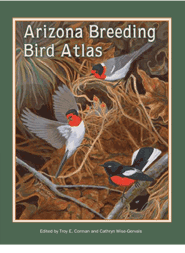 |
 |
|||||||||||||||||||||
|
||||||||||||||||||||||
New Breeding Bird Atlas is Welcome Resource for Arizona Birders
RICK WRIGHT, Aimophila Adventures, 251 East Rudasill Road, Tucson, AZ 85704-6024
Arizona Breeding Bird Atlas, edited by T. Corman and C. Wise-Gervais, 2005. University of New Mexico Press, Albuquerque. $60.00 (hard cover).

Since the publication of Jim Lane’s first bird-finding guide more than 35 years ago, birders visiting Arizona have been well served by a number of excellent “birding Baedekers” for finding the state’s many specialties. Paradoxically, those of us who live here are not as well off. The Birds of Arizona, the classic monograph on distribution and status by Allan Phillips et al., is nearly as old as I am, and with Gale Monson’s Annotated Checklist of the Birds of Arizona about to celebrate its first quarter century, local birders today can find it difficult to place their sightings in context.
This has changed, dramatically, with the welcome publication of the new Arizona Breeding Bird Atlas. Ably edited by two “avian biologists” on the staff of the Arizona Game and Fish Department, and incorporating data collected by over 700 atlas workers (the vast majority of them volunteers), this first major reference work on the state’s birds in 40 years is well designed and richly illustrated, and fully deserves the place of honor it will occupy on birders’ bookshelves, next to the magnum opus of Phillips, Marshall, and Monson. As large in format as it is rich in information, the book is well worth its price.
The field work for this ambitious project began in 1993 and was completed at the turn of this century. Given the size of the area to be covered and the low number of observers available in all but the most densely populated regions, a system of “priority” blocks was developed for the surveys; the difficulties and the sampling methodologies developed to overcome them are described clearly in the atlas’s introductory matter, as are the criteria and definitions used to document each species’ breeding status. The block system allowed more than one-sixth of Arizona’s land area to be surveyed, an impressive accomplishment in a state so vast; eager birders will note, though, that this leaves some 80% of the state open for new discoveries.
The book’s head matter also includes an excellent introduction to Arizona habitats. Covering no fewer than 30 different plant communities, each illustrated in fine photographs, this section will serve all birders, visitors and long-time residents alike, as one of the clearest, most comprehensive overviews of the subject available. It will be particularly useful to those of us whose formative birding days were spent in the East and Midwest, and for whom the effects of altitude are sometimes an easily observed but only obscurely understood mystery.
The results are published in a series of clearly structured species accounts, each of them occupying a full opening and each accompanied by a photograph of the species and a large, easily interpreted map showing the locations of breeding records. The photographs are not strictly speaking necessary, but with few exceptions, they are of good quality and add to the visual appeal of the species accounts. For many species, convenient graphs illustrating breeding phenology and the distribution of breeding records across habitats are also provided.
Although they were contributed by no fewer than 19 different authors, the prose accounts are generally uniform in style; only in the short anecdotal paragraphs introducing each account does the voice of the individual author intrude. The “meat” of each account is rigorously and consistently structured, making it easy to scan for specific types of information. A detailed description of the habitat preferences of each species is followed by a clear summary of the bird’s breeding biology in Arizona, including full and often carefully analyzed information on timing, nest construction, and behavior.
Each account concludes with a discussion of the map data. Many of the most interesting comments here are those addressing the apparent absence of some species (Lewis’s Woodpecker, for example) in areas where they might be expected to breed. Careful readers will note many opportunities for research into these and other topics.
The appendices include a table summarizing information collected during the atlas surveys on cowbird brood parasitism and a nearly 20-page bibliography. The latter is a significant contribution to the resources available on Arizona ornithology, with most of the titles cited post-dating Anderson’s 30-year-old Bibliography of Arizona Ornithology.
As its title suggests, the book covers only those species known or suspected to have bred in Arizona. But even outside of the breeding season, the splendid maps and well-illustrated habitat descriptions will be tremendously useful to birders, visitors, and locals alike.
Editor’s note: $10 or more discount prices for the Arizona Breeding Bird Atlas are available from http://www.amazon.com and the Arizona Game and Fish Department offices or at its website at: http://www.azgfd.gov/i_e/pubs/publications.shtml.
Published March 2006
|
©2005
|
HOME | | | REPORT SIGHTINGS | | | PHOTOS | | | BIRDING | | | JOURNAL | | | ABOUT US | | | CHECKLISTS | | | AZ BIRD COMMITTEE | | | EVENTS | | | LINKS |